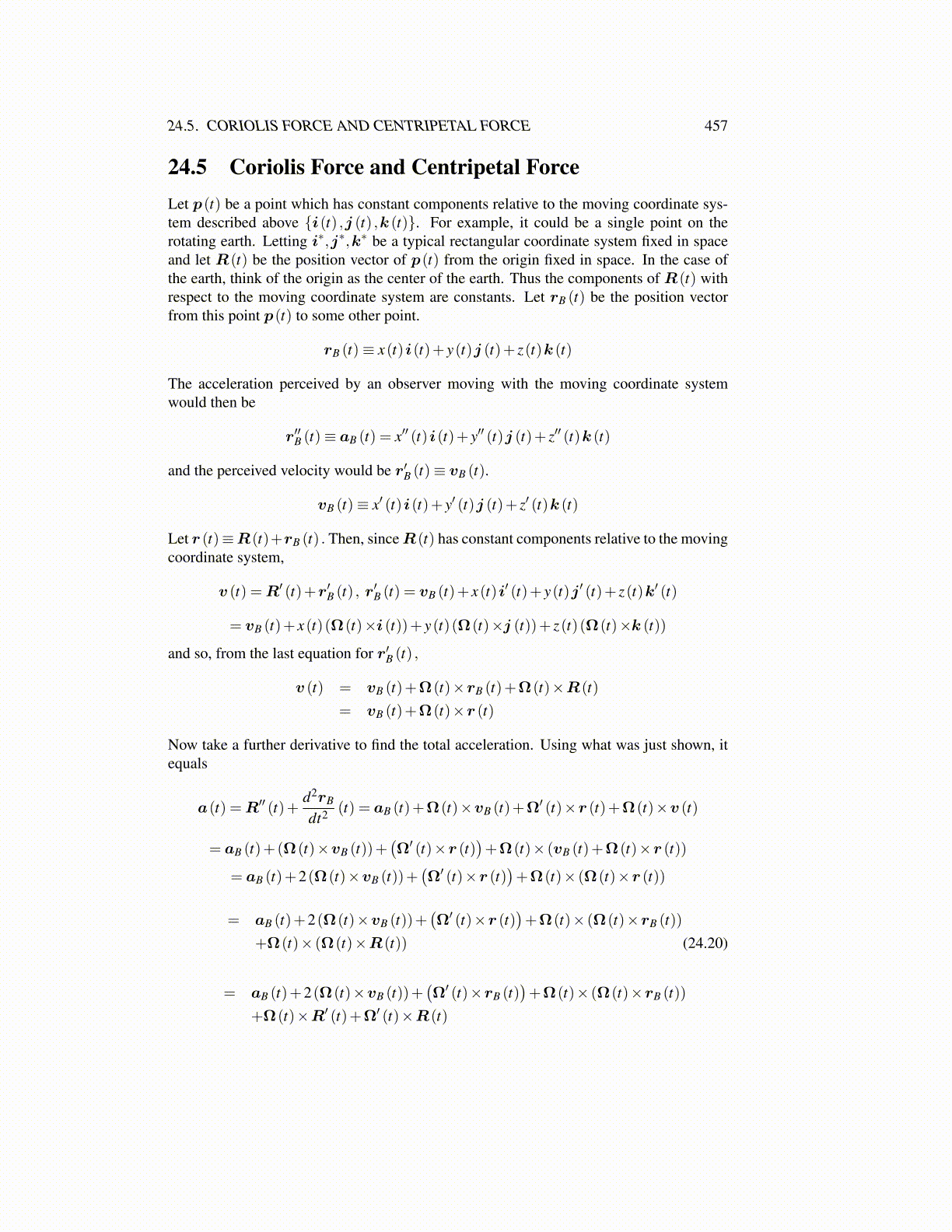
24.5. CORIOLIS FORCE AND CENTRIPETAL FORCE 457
24.5 Coriolis Force and Centripetal ForceLet p(t) be a point which has constant components relative to the moving coordinate sys-tem described above {i(t) ,j (t) ,k (t)}. For example, it could be a single point on therotating earth. Letting i∗,j∗,k∗ be a typical rectangular coordinate system fixed in spaceand let R(t) be the position vector of p(t) from the origin fixed in space. In the case ofthe earth, think of the origin as the center of the earth. Thus the components of R(t) withrespect to the moving coordinate system are constants. Let rB (t) be the position vectorfrom this point p(t) to some other point.
rB (t)≡ x(t)i(t)+ y(t)j (t)+ z(t)k (t)
The acceleration perceived by an observer moving with the moving coordinate systemwould then be
r′′B (t)≡ aB (t) = x′′ (t)i(t)+ y′′ (t)j (t)+ z′′ (t)k (t)
and the perceived velocity would be r′B (t)≡ vB (t).
vB (t)≡ x′ (t)i(t)+ y′ (t)j (t)+ z′ (t)k (t)
Let r (t)≡R(t)+rB (t) . Then, since R(t) has constant components relative to the movingcoordinate system,
v (t) =R′ (t)+r′B (t) , r′B (t) = vB (t)+ x(t)i′ (t)+ y(t)j ′ (t)+ z(t)k′ (t)
= vB (t)+ x(t)(Ω(t)×i (t))+ y(t)(Ω(t)×j (t))+ z(t)(Ω(t)×k (t))
and so, from the last equation for r′B (t) ,
v (t) = vB (t)+Ω(t)×rB (t)+Ω(t)×R(t)
= vB (t)+Ω(t)×r (t)
Now take a further derivative to find the total acceleration. Using what was just shown, itequals
a(t) =R′′ (t)+d2rB
dt2 (t) = aB (t)+Ω(t)×vB (t)+Ω′ (t)×r (t)+Ω(t)×v (t)
= aB (t)+(Ω(t)×vB (t))+(Ω′ (t)×r (t)
)+Ω(t)× (vB (t)+Ω(t)×r (t))
= aB (t)+2(Ω(t)×vB (t))+(Ω′ (t)×r (t)
)+Ω(t)× (Ω(t)×r (t))
= aB (t)+2(Ω(t)×vB (t))+(Ω′ (t)×r (t)
)+Ω(t)× (Ω(t)×rB (t))
+Ω(t)× (Ω(t)×R(t)) (24.20)
= aB (t)+2(Ω(t)×vB (t))+(Ω′ (t)×rB (t)
)+Ω(t)× (Ω(t)×rB (t))
+Ω(t)×R′ (t)+Ω′ (t)×R(t)